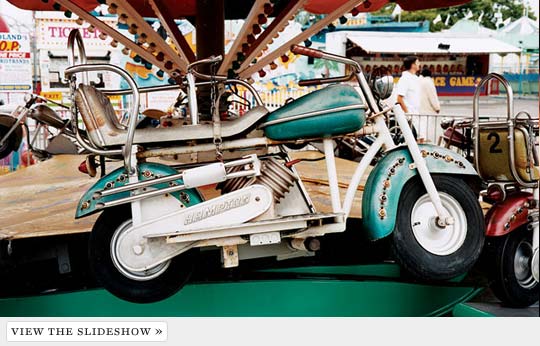
The fun has been threatening to go out of Coney Island since Luna Park burned down in 1944. The “people’s playground,” an escape from the teeming city into the realm of mechanized amusements, has gotten progressively more raucous and dowdy. The Cyclone roller coaster—opened in 1927—rattled on, and the freak shows and hot-dog-eating contests kept the area’s legend alive for new generations weaned on the feral urbanism of the late-seventies gang movie The Warriors (the good gang was from Coney; a mural was painted in tribute to the film on the boardwalk a few years back), but it gradually, inevitably became a kind of living memory.
This is New York City, and real-estate people know what to do with a place like that. Brooklyn developer Joe Sitt along with Taconic Investment Partners have so far spent upwards of $180 million buying acres of oceanfront land. Bit by bit old Coney is shutting down. The possibly sacrilegious nature of this scheme became apparent when the developers added Astroland, one of Coney Island’s two remaining ragtag amusement parks, to their land holdings in November. While the famed Cyclone will remain standing (it’s a landmark and owned by the city), Astroland itself, with its state-fair-style midway, will eventually be gone from the site. Last week, owner Carol Hill Albert, whose husband’s family built Astroland in 1962, got the developer to tentatively agree to give her a reprieve through next summer while she negotiates with the city to relocate her rides to land near the Brooklyn Cyclones’ ballpark—possibly on the lot where the Thunderbolt roller coaster once stood. The Thunderbolt was destroyed by Rudy Giuliani, over preservationists’ objections. The battle over Coney Island’s ghosts has been going on for a long time.
Sitt, meanwhile, has had a number of different plans for what should be built. The first version, unveiled in 2005, included a twenty-story megahotel with, at least in the glitzy renderings, dirigibles docking on the roof and a $1 billion price tag. A summer 2006 update included a glass-enclosed water park on the east side of Stillwell Avenue with an S-shaped hotel with apartments and time-shares. The west side of Stillwell Avenue was slated for a 500-room hotel and a boardwalk condo tower, with the high-rises clocking in at 30 to 40 stories. By last fall’s updated update, the cost was up to $1.5 billion and the drawings featured giant mermaids, a huge elephant, and, if you looked carefully, skyscrapers of the sort that would fit nicely in that other de-gritted city entertainment district, Times Square. One of the towers would have reached a midtownish 50 stories. And, oh yes, amusements. In January, the developer released plans for a Coney Island Park on the Astroland site with a big retail atrium and 21 rides, including an indoor-outdoor roller coaster called the Leviathan, which would loop under the boardwalk. Three hotels and some 400 time-shares are currently proposed to anchor the project, though many of the preservationists believe that condos are an inevitability under the plan. And the old rattletrap collection of rides and attractions, pictured on the following pages, will be gone.
Will New Yorkers be better off escaping the city to this clean and sober, air-conditioned beachfront amusement zone? It’s not so romantic. It’ll certainly smell better. But give it 50 years—Coney’s ghosts will make it their own.